Young Tom Morris and Prize Clubs
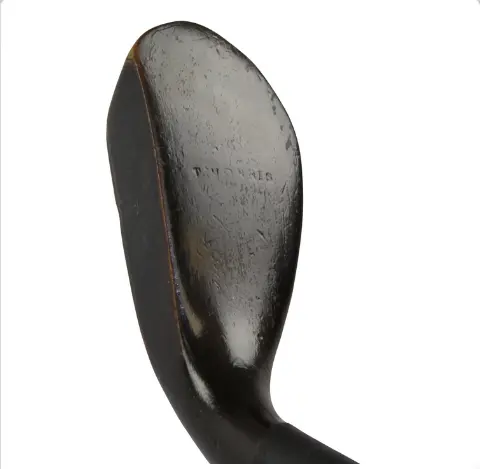

The following article was researched and written by Jeff Ellis
Life is, in many instances, a giant game of “percentages.” We often make decisions based on the odds that something will happen. For example, if we need to buy a birthday present, we shop where the odds are highest that we might find a good gift. Other times we operate on the odds that something is true or false. If we go on a trip, we might decide to stay at a particular hotel or resort based on the reviews that a hotel/resort receives. The better the reviews, the greater the odds that it is a good place to stay.
Like life, the golf collecting world often works on odds. The potential purchase of a very valuable golf collectible in an all-too-often dishonest world begs the question, “Is this item what it is reported to be?” The answer to that question comes down to a collector’s comfort level with the odds that something is or is not what it is reported to be. Understanding that different people can come to different conclusions, I asked myself the question, “Is this item what it is reported to be?” about a Tom Morris putter that Laurie Auchterlonie sold to David R. Foster, former CEO of Colgate-Palmolive, in 1977. Auchterlonie claimed the club once belonged to Tom Morris Jr. and that it was, in fact, the very putter Young Tom used to win his 4 Open championships! If true, just imagine how much that club could be worth! Could there ever be a putter of greater value?
Auchterlonie did not provide any documents or other evidence to back up his claim. We do not know where Auchterlonie acquired the club or from whom. We do not know what he was or was not told when he acquired it. Given the complete lack of documentation of this club prior to 1977, the club itself is the only outside witness to its history.
This putter is marked “T. Morris” on its crown and its long nose shape and characteristics match many other putters made in the shop of Old Tom Morris during the 2nd half of the 19th century. Of that I have no question. But this club is also quite different from an ordinary putter in that it has a silver band around the shaft in the form of a belt, complete with a buckle. The silver band is engraved “C.E. Lamb 18_9”.
The PGA of America became part of this club’s journey in 1977, only after David Foster made his publicized donation of the putter to the former PGA World Golf Hall of Fame in Pinehurst, North Carolina. PGA Historian Emeritus Bob Denney writes about this club and Lamb in a recent letter and states, in part: “During its possession in St. Andrews, the club had a shaft buckle attached bearing the initials “C.E. Lamb,” believed to be Clement Lamb and a relative of Henry Lamb, runner-up in the 1886 British Amateur and reputed inventor of the “bulger” golf club, a wood with a convex face.”
No reason was given as to why the silver band, why Lamb’s name was engraved on the silver band, or how Lamb, a former captain of the Thorntree Golf Club in Prestonpans, just outside of Edinburgh, which is 50 miles from St. Andrews, came to own the club.
The club also has a very unusual original sheepskin grip. Instead of wrapping all the way up to the end of the shaft, this grip stops half-an-inch or so short. Above the grip, the remaining fractions of an inch are covered by what appears to be a black band of India rubber wrapped around the base layer of underlisting. This black band is clearly not as thick as the grip below it.
One has to take leave at this point and wonder how Auchterlonie explained the fact that the club bore the name of someone other than Tom Morris Jr. on the silver shaft band? Lamb’s name is on the club so he definitely once owned it. But why would Lamb have a club that was once young Tom’s? Of course, what golfer worth their tees would not want to own that club! But why Lamb? Plus he lived in Edinburgh, a long way away from St. Andrews.
One has to admit, however, that a club with an ornate silver band indicates that the club, in some way, was special. Auctherlonie, in order to have known himself that this was young Tom’s putter, would have had to acknowledge that Lamb knew this was Young Tom’s club. But if this was known as young Tom’s putter when the silver was put on it in St. Andrews like Denny states, then why was Young Tom’s name not engraved on the silver band? Young Tom was a larger-than-life legend following his death in 1875.
I do not how Auchterlonie explained why Young Tom’s putter bears a silver band with C.E. Lamb’s name engraved on it. But in 1977, Auctherlonie was The Man in the world of old golf clubs. He was the son of 1893 British Open champ Willie Auchterlonie. Laurie was among the last of the great Scottish clubmakers. He knew how to make hickory shaft clubs and all things related. Plus in 1963 Laurie replaced his father as the honorary professional at the R&A. Consequently, when Laurie spoke about golf history his words were gospel. Who alive back then could take issue with anything he said? Nobody.
Today, however, in the information age, there is much more to consider than a simple one man said-so in 1977. Chief among the things to examine is the club itself and what 19th century history has to say about it. Having examined detailed images of the club and the engraved silver band, having lived with my head in the sands of golf history for most of my life, let me here state that, to me, the odds are astronomically against this club having ever been used by Young Tom.
To explain my views that this club is not what it is purported to be, I will first document the use of golf clubs as prizes. I will next document the use of silver-mounted clubs as prizes and presentation items. I will then document the golfing skill of Clement Lamb and how he even won a prize competition in 1889, which is what the remaining evidence shows was most likely the year originally engraved on this club and when the entire club was made.
Competitions that used clubs and balls as prizes were well established by the mid-1800s. Below are a number of extracts from books and newspapers that document this fact.
July 10, 1847. The Arbroath Guide and Weekly Advertiser reports on a golf match held at Montrose the prior Saturday. “On Saturday last a Match at Golf came off for twelve balls, a play club, a putter, and an iron, which were presented to the working classes by Messrs Calvert, Davidson, Pithie, and Thomson.
August 11, 1849. The Arbroath Guide and Weekly Advertiser reports that The Mechanics Club at Montrose played for their silver medal. “There were also four play clubs, put in as prizes, which excited a keen competition.
July 17, 1851. The Fife Herald reported that the “members of the Leven Golf Club met on Scoonie Links to compete for their best silver medal. The winner turned out to be Matthew Elder, who won in a playoff of Wm. Henderson. Then it reports that “A very handsome play club presented by Mr. John Patrick, was gained by Mr. Peter Keddie.”
June 30, 1853. The Fife Herald reported on the half-yearly competition held by the St. Andrews Golf Club. “The medal was gained by Mr. George Morris at 93 strokes; the cross by Mr. John Lynn at 96. With odds allowed, the prizes were gained as follows:—1st, The Club’s prize, a play club, by Mr. David Clark. 2nd, The putter, presented by Mr. A. Downie, by Mr. Alex Galloway. 3rd & 4th, Two balls from Allan Robertson, and two balls from Tom Morris, by Adam McPhereson and Wm Halkerston, equal. 5th The club’s ball, by George Bruce. 6th, the Club’s ball, by Wm. Ayton, sen.”
December 3, 1854. The Fife Herald reported that The Crail Golfing Society held a competition for the club medal, which “was gained by Matthew Elder, Leven. A play club, kindly presented for competition by Mr. James Wilson, St. Andrews, and two balls were then played for.”
June 24, 1858. The Fife Herald reported that “the members of the Leven Golf Club played on Monday afternoon for as many prizes as there were players playing. Of course, they varied in value. The highest prize, a play club, was won by Mr. Alexander Tullis.
January 4, 1859. The Dundee, Firth, and Cupar Advertiser reports on the first competition held by the St. Andrews Mechanics Club. “The first prize, an iron.... The second prize, a play club, presented by Mr. Forgan…. The third prize, three golf balls, presented by Mr. George Brown…. The fourth and fifth prize were equal, two golf balls each, presented by Mr. Allen Robertson and Mr. George Brown.
December 30, 1864. Under the title of “A Golf Match on New Years Day”, The Montrose Standard and Angus Means Register (4) reported that the Union Golf Club intended to hold a competition where members would compete for “a number of prizes, consisting of a dozen golf clubs, of various kinds, and ten golf balls.”
The Golfers Yearbook for 1866 reports that on May 17th Royal North Devon and West of England Golf Club held their Challenge Gold Medal Competition. George Glennie won the medal, but “J.W. Adamson, Blackheath, took the prize of nine beautifully finished clubs.” In addition, “Rev. E.O. Vincent, the silver Cross, given by General Moncrieff, in addition to seven Clubs; and G. Molesworth, a prize of five clubs.”
This same book reports that on August 18, 1866, the Elie and Earlsferry Golf Club held “a special handicap match for a set of nine clubs from the establishment of Tom Morris—the gift of Lieut.-Colonel Babington of Gibliston House.”
September 24, 1867, The Scotsman reported that a keen competition took place on the Links at Burntisland the day before, and “a handsome set of golf clubs had been offered as a prize to the usual players, whether visitors or natives, and a couple of balls have been thrown in as a second. Thirteen competitors entered…. The match being the best of three rounds, or fifteen holes.”
The practice of using golf clubs as prizes in a golf competition continued to grow. By the end of the nineteenth century, playing for clubs, balls, and other prizes in the UK was widespread.
On the club in question, Lamb’s name is engraved on a silver band wrapped around the shaft, just below the grip. When a silver band or other silver ornamentation (such a silver cap on the end of the grip) was used to dress up a golf club, the publications in the 1880s and 1890s referred to such a club as a “silver-mounted golf club.” Such clubs were typically given out as either awards or as special gifts to commemorate an event or honor the person who received the silver-mounted club(s). Below are some examples of silver-mounted clubs referenced in print.
February 20, 1892. The Greenock Telegraph and Clyde Shipping Gazette reported that the golf club at Kilmalcolm had grown to 130 members. “The Links are at present being greatly taken advantage of, chiefly by competitors for the various prizes, many of whom are invariably to be found at practice….. The prizes given by Mr. Robert Cassels and Mr. A.T. Taylor, competition for which is presently going on, take the form of six silver-mounted golf clubs and four silver-mounted golf clubs respectively. The winner of the contest to receive Mr. Cassels’ prize, and the second Mr. Taylor’s prize.“
November 21, 1899. The Devon Tribune reports “Golf Club—On Tuesday and Saturday a competition took place amongst the ladies of above club for prizes presented by Mr. Gardner, Tillicoultry House…. The prizes were silver mounted golf clubs.”
January 1, 1896. The Dundee Courier published an article titled “Carnoustie in 1885” and recounted when the course there was opened after a long reconstruction project. “Sir Charles Tennant, in opening the course…drove off the first ball with a silver-mounted golf club bearing a suitable inscription which was presented to him by Miss Edith Colquhoun…”
May 13, 1892. The Irving Herald reports a big celebration at the Prestwick St. Nicholas Golf Club. “The new golf course which this club has recently acquired on lease was formally opened for play on Saturday by the captain, Mr. A.J. Larke….. The hon. Secretary, Mr. Caldwell, in presenting Captain Larke with a handsome silver-mounted club with which to drive off the first ball, said….”
February 27, 1893. The Northern Whig reported the opening of the Ormeau Golf Links and how James Woodside, the captain of the club, “amid cheers, presented Mr. Masterson with “a silver mounted golf club.” It was engraved with “Mr. Masterson’s monogram and the following inscription: Presented to William Masterson, Esq, J.P., on the occasion of the opening of the Ormeau Golf Links, 25th Feb 1893.” William Masterson was the chairman of the parks committee, which played an important role to helped make the course a reality. Masterson thanked the Club for their kindness and then “a ball was placed on a tee, and Mr. Masterson, having struck it, declared the links open.”
I have many more additional accounts of course openings where a silver-mounted golf club was presented to the individual selected to drive off the first ball and thereby open the course. In addition to being awarded as prizes or used to honor a person when opening a golf course, silver-mounted clubs were sometime simply given as gifts.
October 25, 1897. The Aberdeen Journal reports on a big engagement party and presentation of gifts to honor Miss Edith Ross Ferguson. Chief among the gifts Miss Ferguson received, which “was subscribed for by between 80 and 90 of the members of the Peterhead golf club” was “a set of silver-mounted golf clubs and bag.” The article then gets more specific “On a silver shield on the bag is an inscription, and on each of the clubs is a silver band with the bride’s initials.”
So, from the sources quoted above, we learn that it was common for many golf competitions to present prizes, and the prizes often consisted of clubs—sometimes silver-mounted clubs. We also learn that silver-mounted clubs could be given to honor individuals and not just awarded as prizes. We further learn that a golf club shaft with a silver band engraved with the name of the recipient was at least sometimes used on a silver-mounted club.
Clement Lamb—Captain and Competitor.
Clement E. Lamb was an avid golfer and consistent participant in many events where prizes were awarded. He was also a fine competitor. The Edinburgh Evening News of January 29, 1885 reports that “The Prestonpans Club medal played for on Saturday was won by Clement Lamb.”
Lamb was so involved in the game that, according to the August 26, 1887 issue of The Haddintonshire Courier, he was elected captain of the Thorntree Golf Club in Prestonpans. The paper reports that after the annual meeting of the Thorntree Golf Club, “the members competed for the silver medal, the captains, and other prizes.”
The September 22, 1888 issue of The Field, reports that at Luffness “the annual competition for the captain’s and other handicap prizes took place on Saturday” C. Lamb was listed as a competitor along with many others.
The November 2, 1888 issue of the Haddingtonshire Advertiser reports on the Thorntree Golf club quarterly competition. “Notwithstanding the boisterous weather, which rendered good scoring an impossibility and brought a large number of players to grief, there was a fair turnout of competitors. The medal was won by Mr. Clement Lamb, captain of the club, his score being 96, less 11—85.
The Edinburgh Evening News of October 28, 1889 reports that “The quarterly competition of the Thorntree competition was held Saturday. The prize-winners were : J. Stenhouse, (medal) 86 (scratch) C. Lamb 95-8 -87; J. Fraser, 92; J Richardson,2102-10-92; J Fairgrieve, 93; R Stewart 99, Wilson, 111.”
In the above account from 1889, Lamb was the first prize winner after the medal winner. That prize could have easily been a putter.
In addition, there are other publications that list Clement Lamb as a participant in a prize competition.
With regard to Mr. Clement Lamb, we learned that he played in many competitions, was a solid player, and he even won a prize in a competition in 1889. The silver band on the shaft of the putter purchased by the American collector would make this club a silver-mounted club, and his name on the band clearly indicates that he won this club or was honored with this club as a gift.
It should also be noted that the grip on this club in question is the original sheepskin grip. You can see the indentation of the original whipping just below the whipping near the top of the grip. But the very top of this grip is missing something. There is a large black piece of India rubber wrapped around the end of the grip seems quite out of place, as golfers did not use grips that were made with exposed India rubber at the top. This piece, however, originally had a purpose. It was the underlayment that helped fit/attach a silver cap to the end of the grip. A silver cap that was likely also engraved. But if it was engraved with the answer to why the club was given to Lamb, the cap would need to become lost for this club to fit the Young Tom narrative.
It can be said that the grip on Lamb’s putter is a replacement, done in the 1880s. The club, however, shows only light wear, and the light wear on the grip is consistent with the rest of the club.
It is curious to note that the date on the shaft band is missing the third of the four numbers that indicate the years. As shown in an image at the end of this paper, all that is left is “18_9”. Yet, if you look at the way the 8 is made, it is quite distinct in that it uses a distinct “diamond” shape in the lower left and lower right of this number. Plus there is a simple bent line that connects the two diamonds to form the bottom off the 8. If you look at the next number after it, the number that is missing, you can clearly make out two diamond shapes. If you look close enough there appears to be the remains of a bent line that connects the two diamonds. This clearly raises the odds that the next number was once a slightly smaller “8” as well.
The fact that this club has a silver band engraved “C.E. Lamb” as well as a year, that the grip once had a silver end cap, and that the shaft is painted black all indicate that this putter could easily have been a prize or presentation club. The silver band set against the black shaft, the silver end cap atop the finely made sheepskin grip, and the year and name of a man who played in many prize competitions including in 1889 documented above, move the odds for me to pretty much 100 % that this club was won by Clement Lamb in a prize competition in 1889, or at least given to him as an award that year.
If that is not enough, the clubhead itself would have had to have been made prior to 1868 if Young Tom used it to win in 1868. Problem is, the clubhead does not date anywhere close to 1868. It is neither as long nor as sleek and shallow as those clubs made in the 1850s and ‘60s. Instead, it’s short head length, tall face depth, and thick neck are typical late 1880s fare.
To demonstrate this fact, I have pictured Lamb’s putter next to “Auld Pawkie,” the putter used for many years by Willie Park Sr. Park played against young Tom and won the Open in 1860, 1863, 1866, and 1875. The differences between Park’s putter and Lamb’s putter are dramatic—far more dramatic than the difference between even an 1840s putter and an 1860s putter. This is because when the long nose era came to a close during the late 1880s, the clubheads became shorter and shorter, and much more compact.
The first image below shows the silver plate affixed to Park’s putter when it was presented to J. Stewart Paton of Woking Golf Club by Herbert F.H. Caldwell in 1930. The putter remained on display at Woking until the club sold it at auction in 1996 to raise funds. The silver plate on the shaft was inscribed in part, “This Putter ‘Auld Pawkie’ was used by Willie Park Snr, Musselburgh, in the Championship of 1863…”
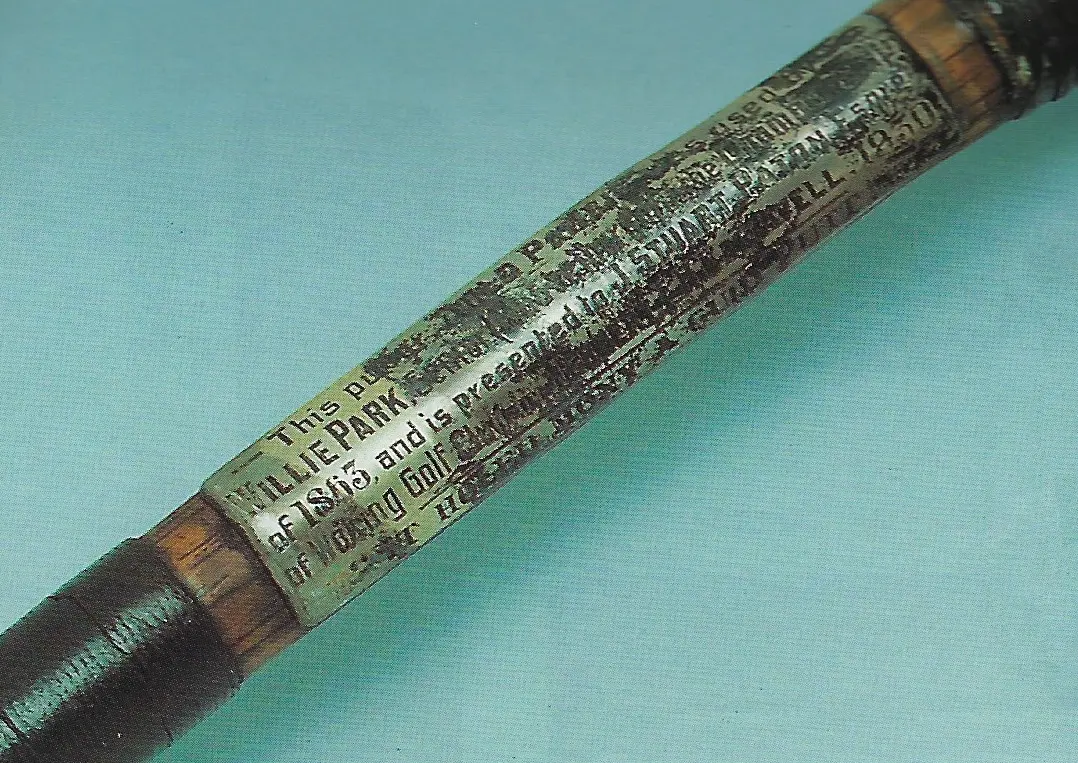
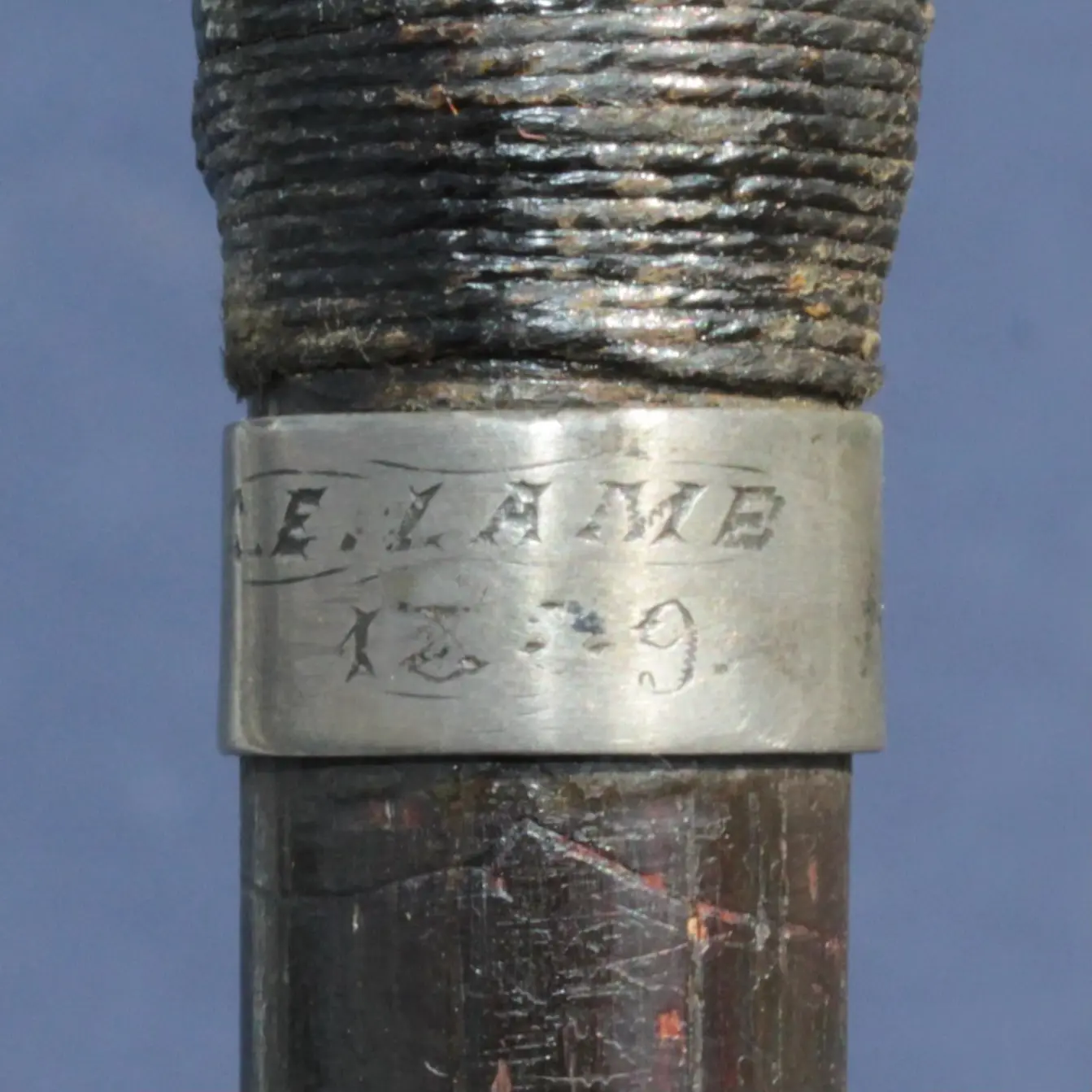
In the next three sets of images, note how the neck of Park’s putter on the left is smaller than it is on Lambs putter on the right, yet the head of Lamb’s putter is much shorter than Park’s. Long nose putters with such relatively short heads were the norm in the late 1880s.
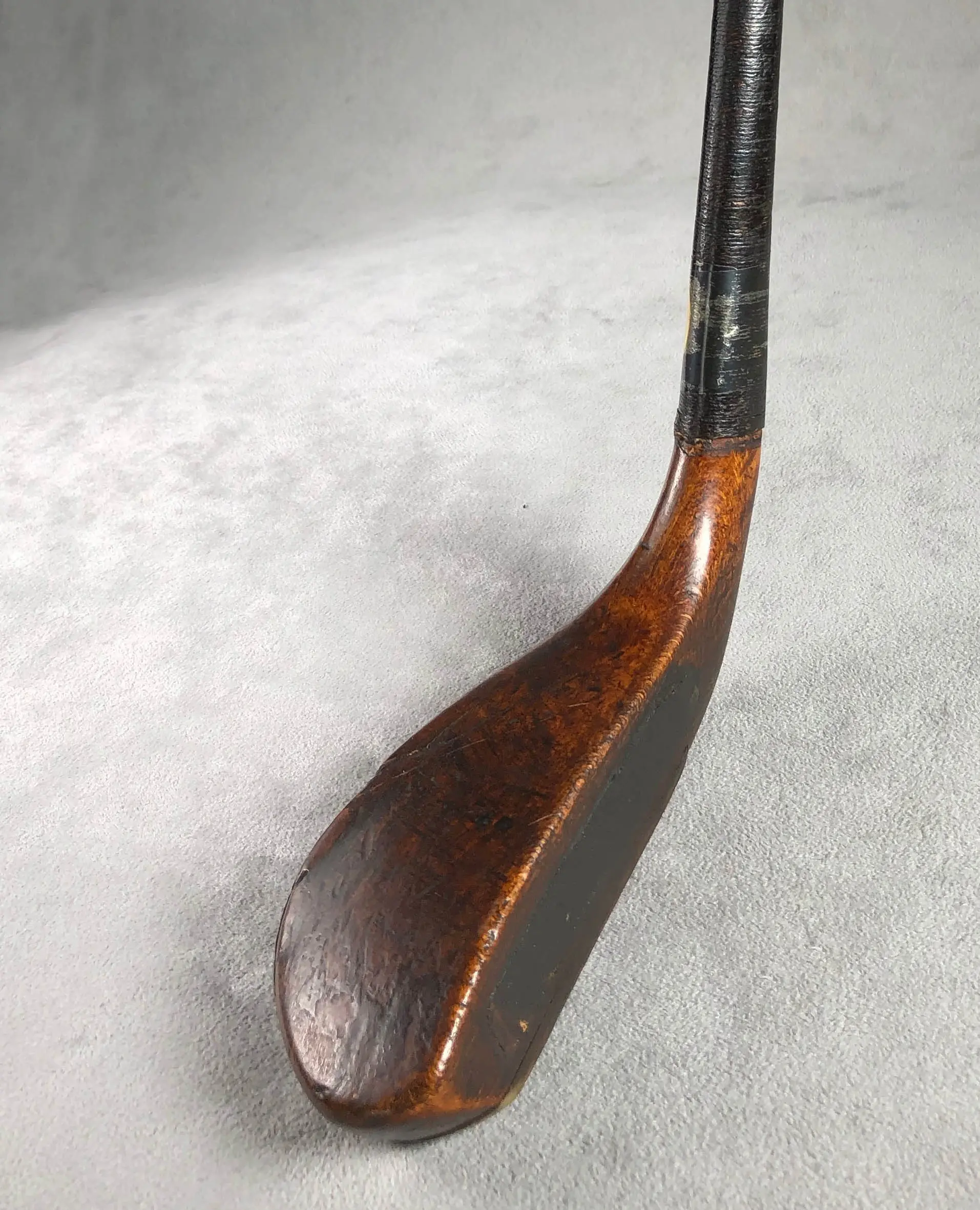
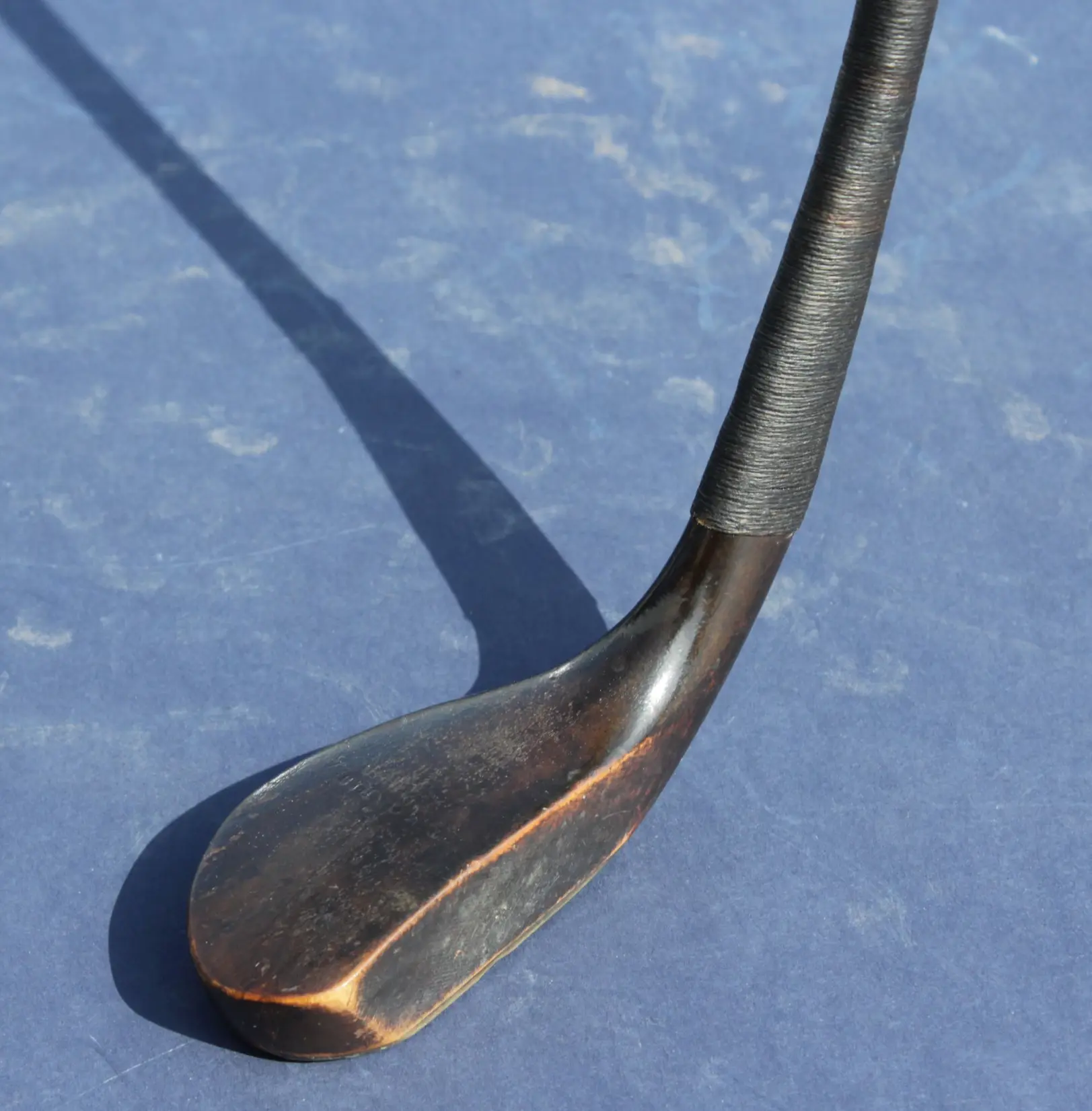

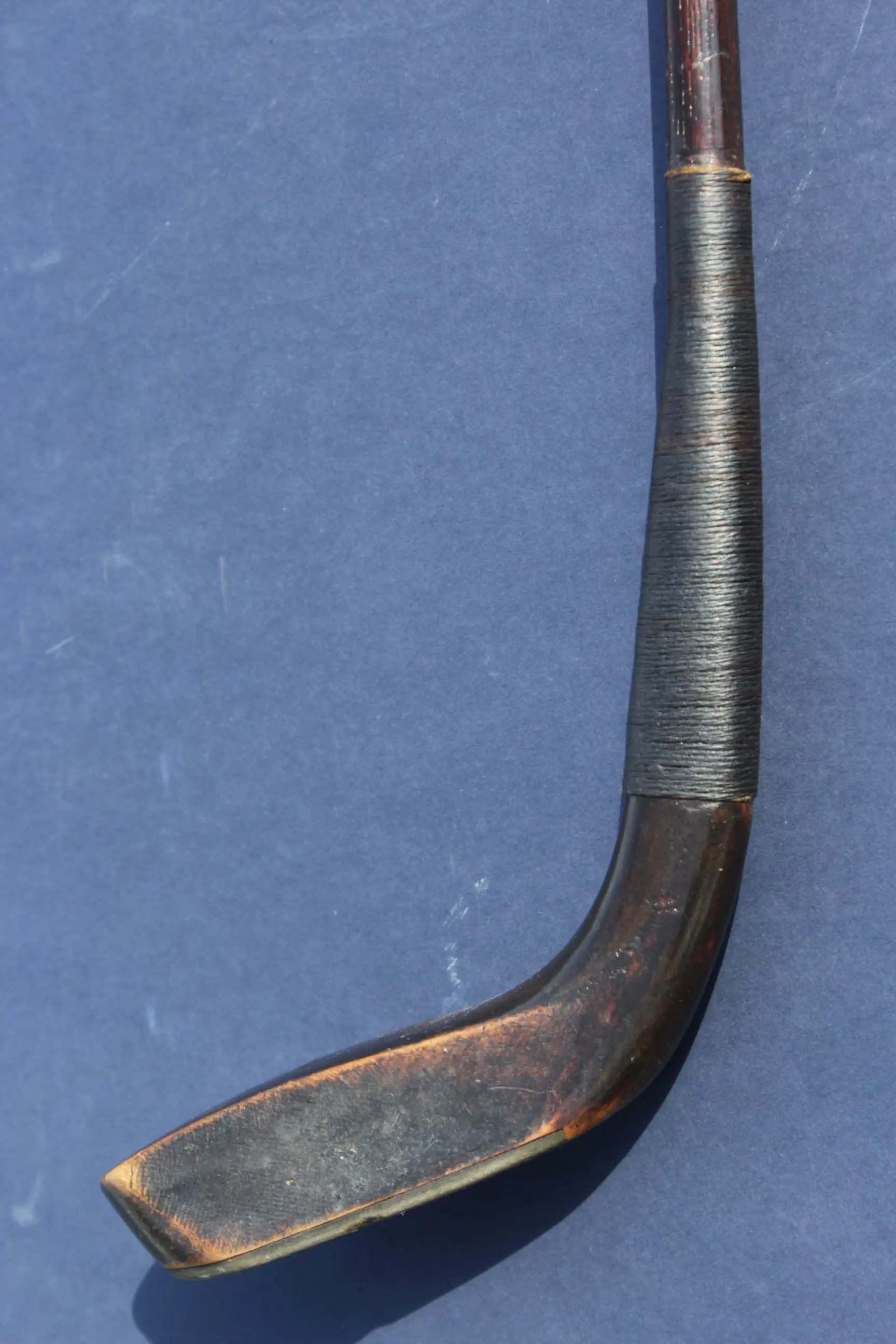
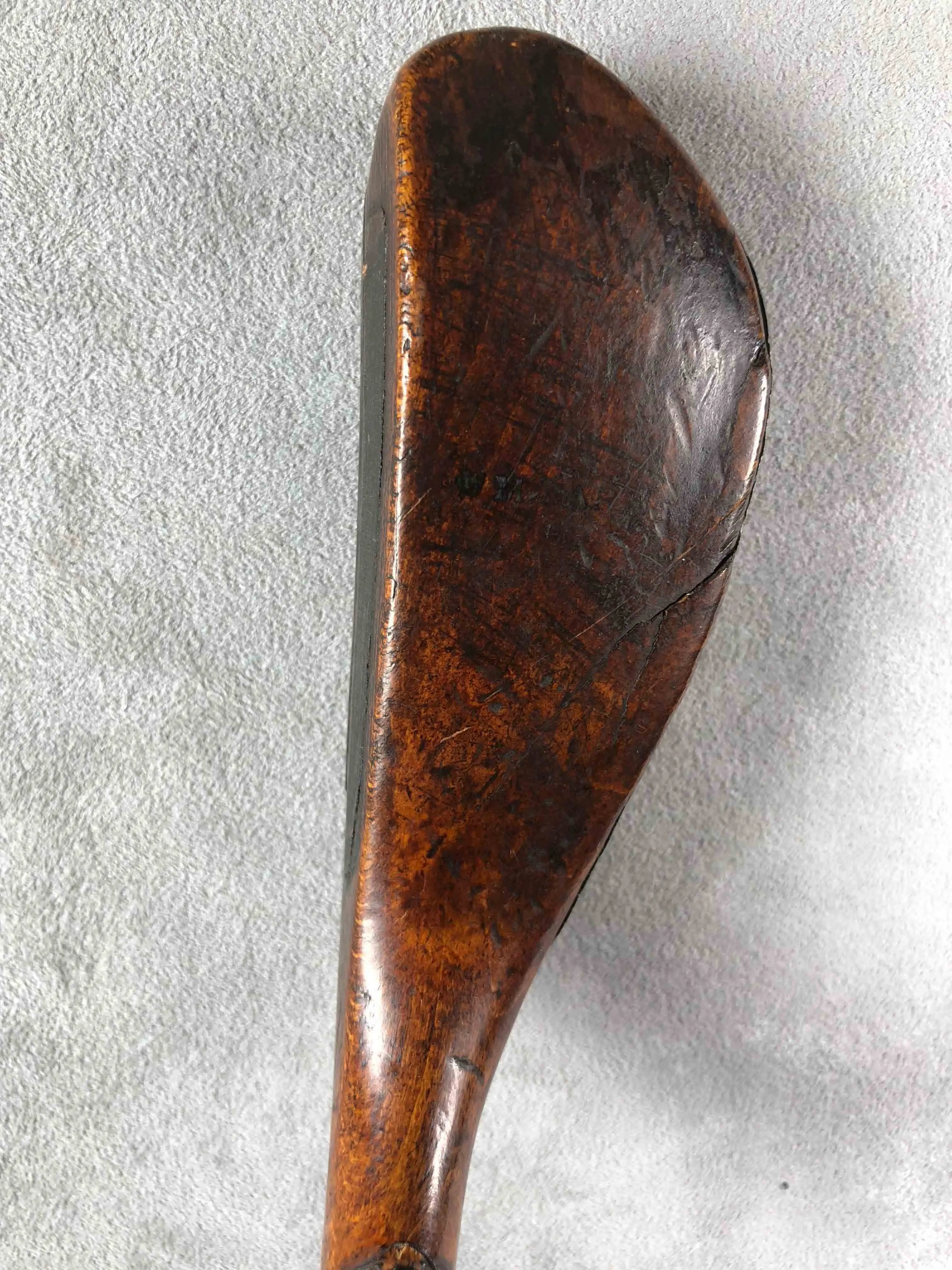
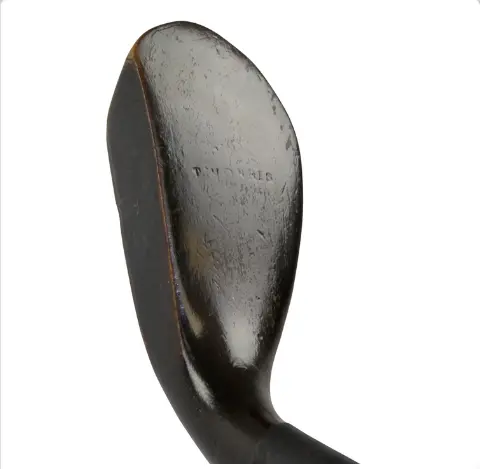
The black India rubber wrapped around the very end of the handle most likely once held a sterling silver grip cap. There would be no other reason for it to be there.

This image shows a silver grip cap on the end of the grip. This club is a silver trophy club made in 1903, as is engraved on the end cap. It has decorative silver golf balls attached to silver shaft bands affixed around the shaft. Each band is engraved with the winners names and the year that they won the 2-man team event. New winners were added to this trophy every year.
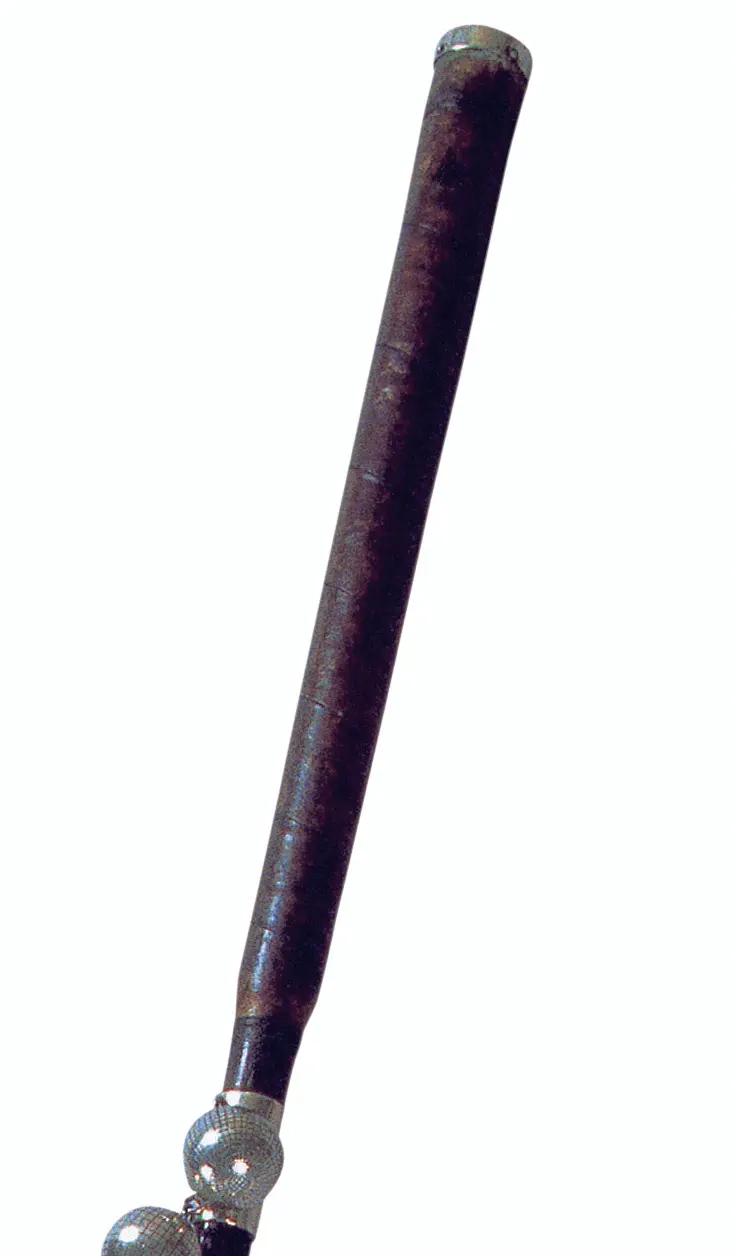
The arrows below show the two unique diamonds and angled line that connects them in the 8 clearly shown. The number next to it is no longer recognizable for some reason. It does appear to have, however, the same two diamonds the same distance apart and an angled line that connects them. (These fine hand-engraved markings are best seen on a computer screen). I believe the odds are quite high that the missing number was once a slightly smaller 8.
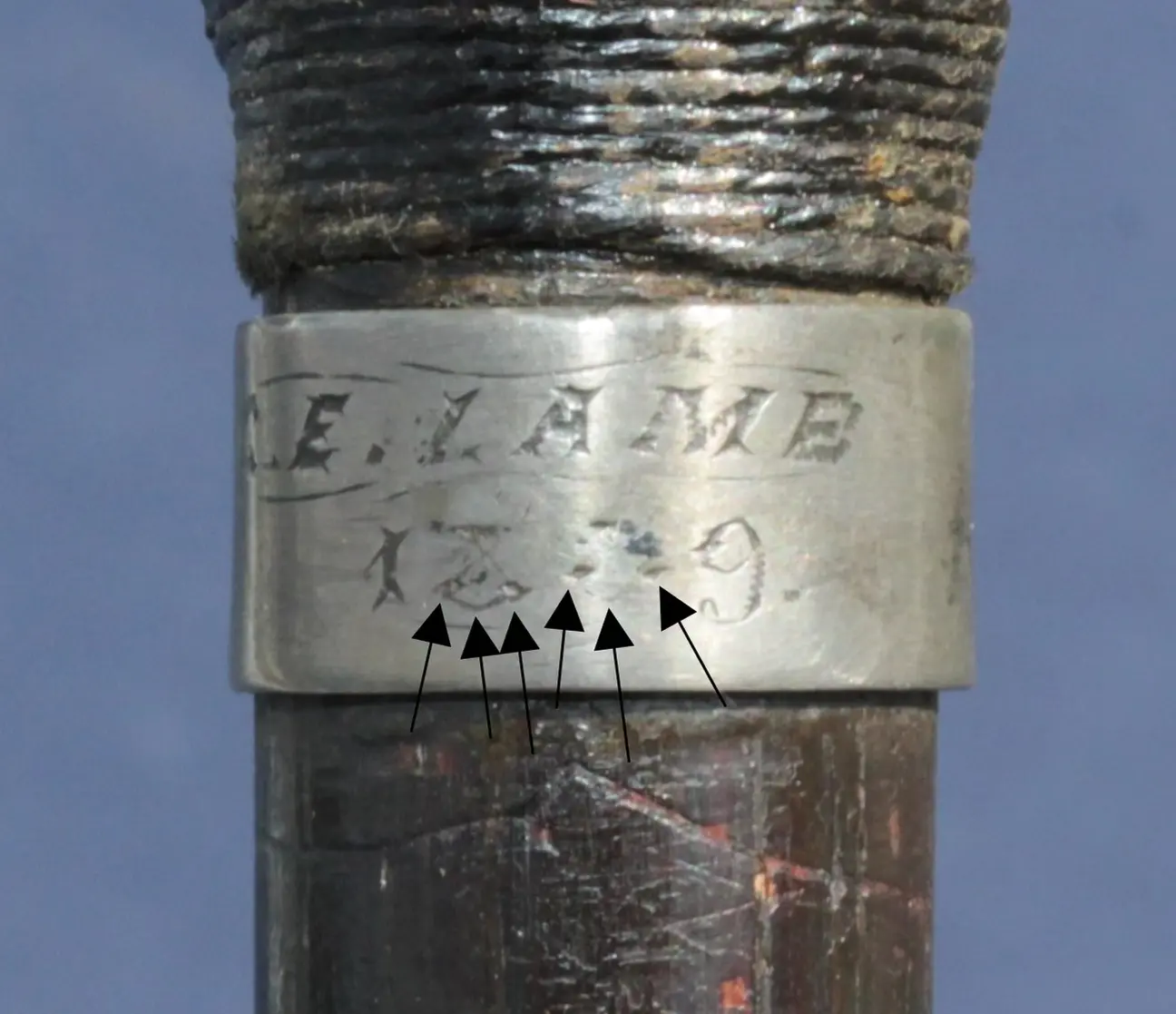
My love for the history of the game is undeniable, at least to me. I value the artifacts that remain for us to marvel over and enjoy. These ancient clubs document not only the evolution of the game's equipment but also the passion for the game as felt by the golfers who used them. Their fascination and passion for the game was no different than ours today.
In the middle of all of this, when I recognize that something is being presented that could mislead a significant part of the golf world in its understanding of its history, I feel a responsibility to speak out. I mean no ill will to anybody involved with this club in the past or present.
Taking an in depth look at this particular club serves to remind all of us collectors that the bigger the claim, the closer we need to look.
I wish to thank the good people at the PGA of America for their understanding and support of my research.
One last item. Since the topic of early prize clubs was discussed earlier. The images below show two clubs made by John Patrick, the same John Patrick mentioned earlier in this article. The July 17, 1851 issue of The Fife Herald reports that Patrick donated “a very handsome play club” that was won by Mr. Peter Keddie in a golfing competition held by the Leven Golf Club.
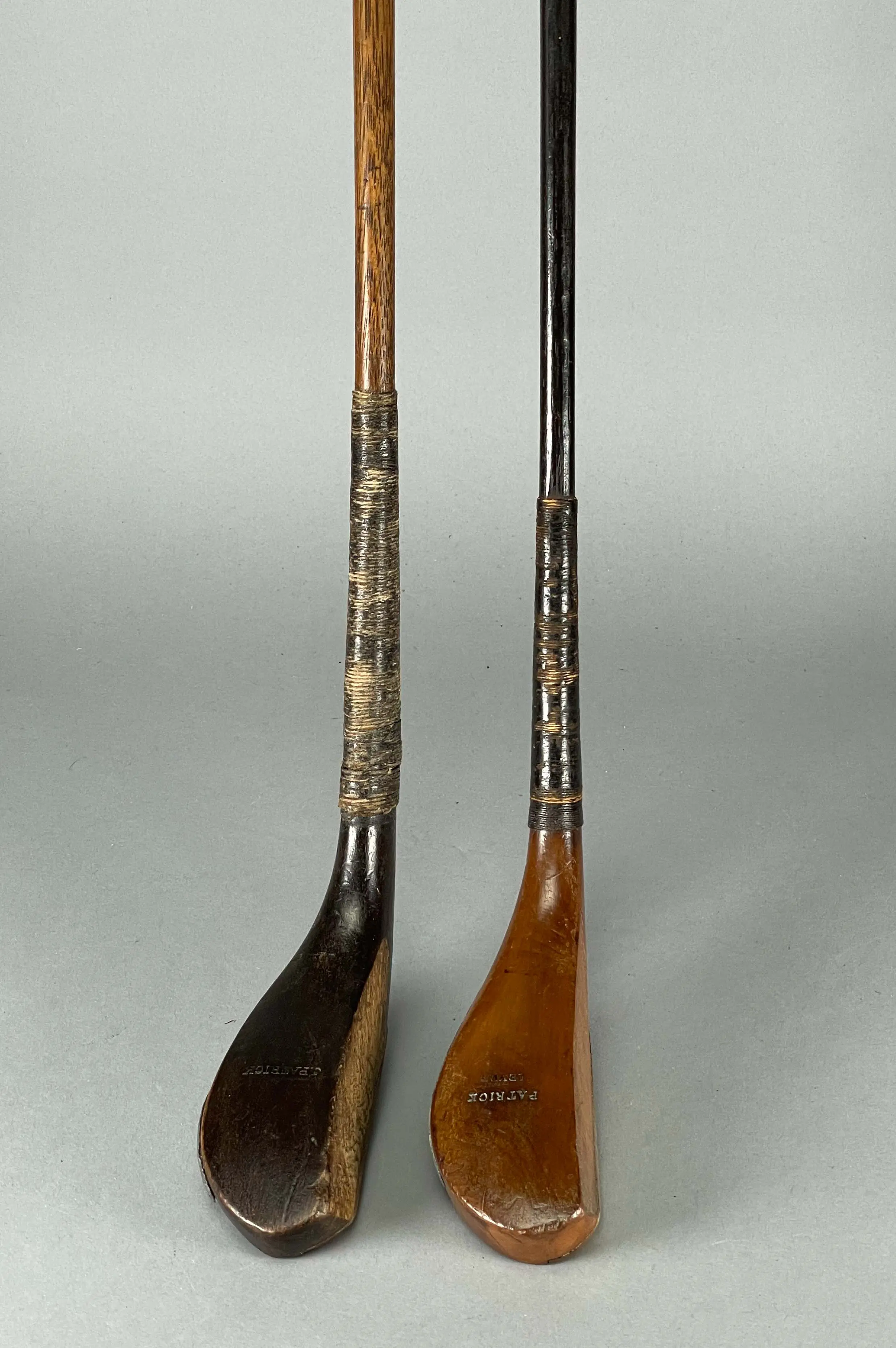
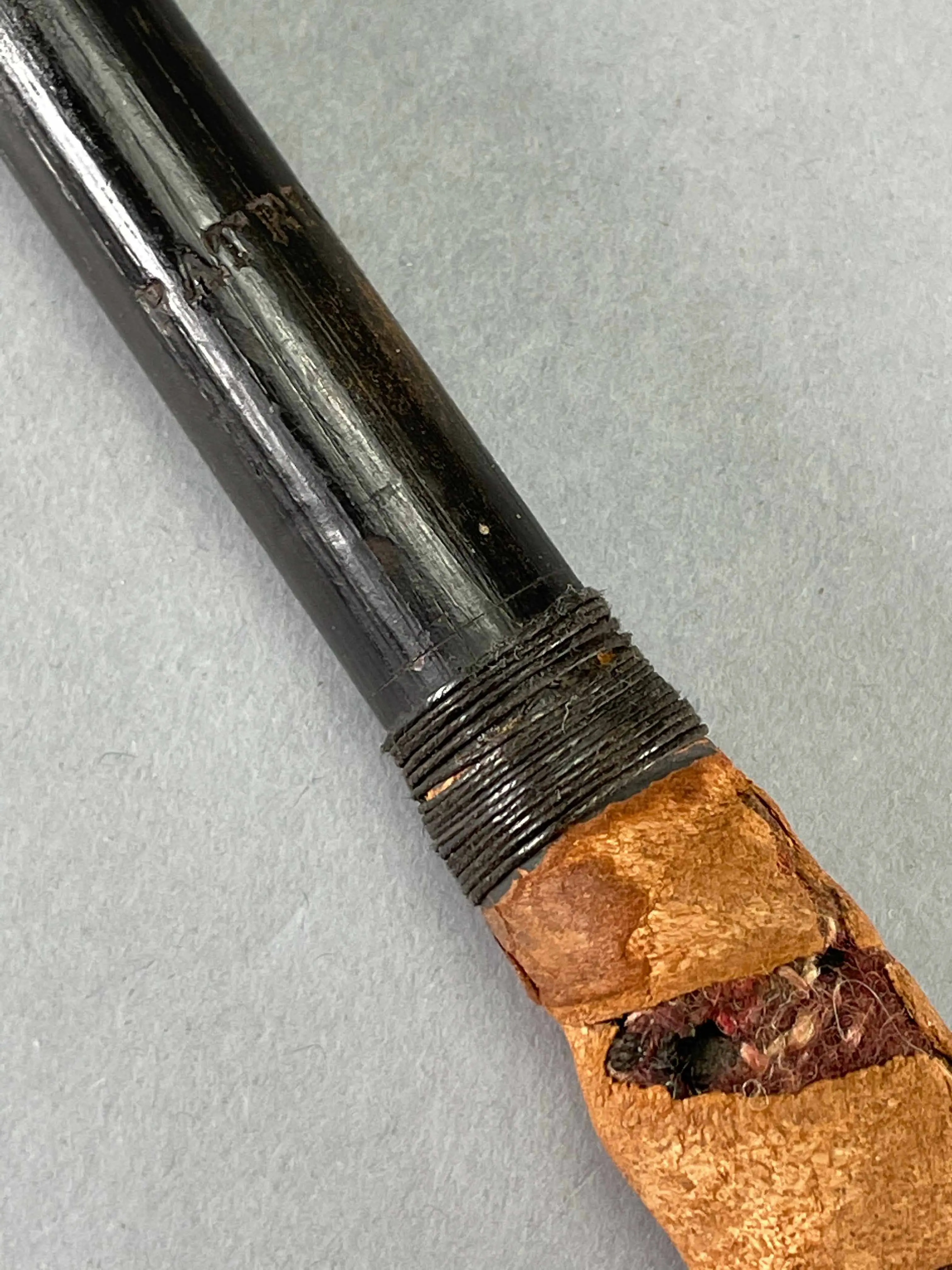
The circa 1855 short spoon on the left has a blackish-brown finish on the head, a varnished hickory shaft, and “J. Patrick” stamped on the crown. The c. 1850 middle spoon on the right has a light reddish-brown finish on the head, a black-painted, “Patrick, Leven” stamped on the crown, and the shaft is stamped “Patrick.” The odds are quite high that the strikingly handsome club on the right was made as a prize club. Here’s why.
Blackish-brown was a finish color often used by clubmakers. Light reddish-brown finishes, however, are extremely rare. Virtually all golf clubs made before 1890 have varnished, not painted, wood shafts. The painted black shaft shown is a true anomaly. It took more work to finish a shaft in paint. The “J. Patrick” maker’s stamp is neither as rare nor as informative as the “Patrick, Leven” stamp. Finally, the “Patrick” stamped on the black shaft under the grip puts this club among the absolute oldest clubs with a maker-stamped shaft that I have encountered. Stamping the maker’s name on the shaft was extra work, and the practice of doing so did not begin to take hold until the 1880s, and then by just a few makers.
When you consider all the features found in the club on the right that are not normally found on Patrick’s clubs, it is easy to make the case that this is a specially made club. The most likely reason for a special made club would be to use it as a tournament prize, presentation piece, or to fill a specific order for a prominent individual. One thing that is for sure: Both clubs are great! Wonderful examples of a maker whose work is seldom seen. Patrick, however, sure put his best foot forward when he paired a black shaft with this reddish-brown head. What a gorgeous club!